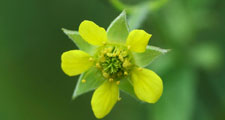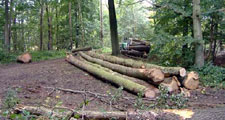Restoring Ancient Woodland
Woodland Management
Planted Ancient Woodland Sites (PAWS) and Modified Ancient Woods
Many ancient woodlands in County Durham have been felled and replanted within living memory. Much of their biological and historical interest has been lost, but some elements – flora and fauna, veteran trees, old wood banks and tracks – may survive. Other ancient woods, while not comprehensively felled, have been substantially modified over the years by the introduction of commercial or ornamental species. Restoring replanted or modified woodlands to a more natural condition can allow the biodiversity of the woodland to recover over time.
Identifying Planted Ancient Woodland Sites
The process of identifying PAWS is essentially the same as for ancient semi-natural woodlands although some of the evidence on the ground can be more difficult to find. The presence of Ancient Woodland Indicator Species in the ground flora can give an indication of both the history of the site and the extent to which it is likely to respond to restoration.
Published Guidance
The Forestry Commission has published guidance on managing semi-natural woodlands as part of The UK Forestry Standard (Standard Note 5) together with more detailed guidance in FC Practice Guide: Restoration of native woodland on ancient woodland sites. Some of these can be downloaded from the Forestry Commission website.
The Woodland Trust has recently published guidance on “The conservation and restoration of plantations on ancient woodland sites” which can be downloaded from the publications page of the Woodland Trust website.
Restoration and Restocking
Restoration is usually best achieved by the gradual removal of introduced species, and a phased transition to native woodland, either through natural regeneration or planting. Maintaining woodland cover in this way reduces the disturbance to existing flora and fauna as well as landscape and visual impacts. In some woodlands clear felling by compartment may be the only practical option, and particularly in stands of under-thinned softwoods vulnerable to wind-throw. In such cases compartments should be kept as small as practical to minimise disturbance.
As much of the relic biodiversity of PAWS resides in the soil and the ground flora it is particularly important to minimise physical disturbance generally and to use low impact felling and extraction techniques.
General Principles
- Get to know the wood. Identify and map areas of ancient woodland, replanted or modified ancient woodland, secondary woodland and plantation. Identify relic features like veteran trees, stands of native species, ancient woodland ground flora, woodbanks or charcoal hearths. Observe variations in slope, drainage, aspect and soil that may influence the composition of the Native Woodland Types you wish to restore.
- Find out as much as you can about the history and ecology of the wood. The County Ecologist and Durham Wildlife Trust may have information on its flora and fauna, and the County Archaeologist and local history societies on its historical interest.
- Find out if there are any environmental designations – SSSI, County Wildlife Sites, Scheduled Ancient Monuments, Conservation Area, Ancient Woodland etc – that might affect how the woodland needs to be managed.
- Find out about any protected species that may be affected by operations (particularly bats and red squirrel). Contact specialist groups if necessary.
- Take advice. The Forestry Commission provides advice, grants and useful publications on restoring and managing native woods. They can also recommend specialists for carrying out more detailed assessments. A Woodland Assessment Grant may be available to help you undertake assessments of ecological, landscape, historical and cultural factors and for community involvement.
- Consider the interests of local communities. Many ancient woodland sites are places of local folklore and tradition and may contain features of value to local communities – like landmark exotic trees.
- Draw up a management plan and monitor its implementation.
- Restore the native woodland typesthat would have been present historically on the site.
- Minimise the scale and pace of change – wildlife takes time to adjust. Remove non-native species progressively where practical, prioritising areas with remnants of native woodland ground flora.
- Maintain a mature habitat where possible. Retain old trees, and dying and diseased trees where it is safe to do so, along with standing and fallen deadwood.
- Use low impact felling and extraction techniques. Extraction along established rides, with low ground pressure vehicles or with horses can help minimise damage to sensitive ground flora.
- Preserve historical features like ancient rides, woodbanks, charcoal pits and archaeological features and keep them clear of planting or natural regeneration.
- Maintain diversity of habitats within and around the wood and particularly features like open glades and wetlands. When creating or restoring areas of open space, relate it to wetlands, watercourses, rides, outcrops and cultural features.
- Use natural regeneration where possible for restocking. When planting is necessary – for example where there are few native trees of seed-bearing age or where browsing by deer make natural regeneration difficult – use the appropriate species for the native woodland types likely to have been present on site. Planting patterns should be naturalistic. Plant material should be of local origin or from the nearest FC Seed Zone.
- Give veteran trees space – don’t restock too close to them.
- Look to areas surrounding the woodland for opportunities to extend it, or manage them sensitively to compliment the woodland habitat – for example by creating conservation headlands around arable fields, or restoring hedgerows to improve connectivity.



